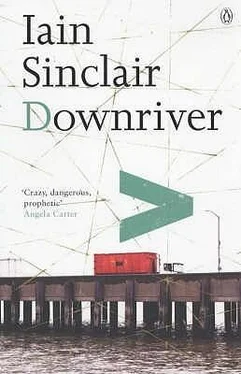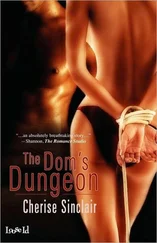The train shudders in fever, its woodwork creaking and splintering. The roof tears away like skin on a custard. The night rushes through us. The wheels glow to scarlet over the melting track. Uprooted trees hurtle against the side of the carriage. It cannot be sustained. The wind drops and, in the stillness and the painful silence, the landscape gets away. Buildings are sand-slides, scrub-woods replace them, flake and peel, are themselves replaced by fires, snowstorms, bears, wolves, shapeless predators.
Our eyes are covered by the leaking terracotta of our hands. Night and day are a single moment. Our throats obediently anticipate future terrors. The train is a projectile fired through damage and hurt. The unrecovered desolation of Stratford. The fire raids. Phantom bombers dropping below cloud cover to follow the quisling ribbon of mercury that is the Thames: to target destruction on the wharfs and refineries of Silvertown and Custom House. Gaunt churches stand in fields of ruin. The dead chatter like starlings in the flight path of rockets. The purgatory of George Gissing smoulders around us: ‘ pest-stricken regions of East London, sweltering in sunshine which served only to reveal the intimacies of abomination; across miles of a city of the damned… stopping at stations which it crushes the heart to think should be the destination of any mortal; the train made its way at length beyond the outmost limits of dread …’
And if there is a destination, beyond the nightmare, it is North Woolwich; graveyard of engines. I step out, tentatively, on to the morning platform. The fresh chill of the river greets me. Cold, clear sunlight outlining a reassuring solidity of objects: benches, barriers, bricks in the wall. The Telecom ‘saucers’ lift like promiscuous mushrooms; rat-bitten on the stalk. Everything has been swept, scrubbed, polished; made safe. The station is now a Museum of Steam, a tamed mirror-version that would deny its own madness. We are soothed; we enter a past that is narcotic, careful to avoid any engagement with present furies. It removes itself, with condescension, from the debate of opposites; remaining an attractive fossil. North Woolwich is nowhere, sleep’s terminal: I welcome it.
V
Too weak to resist, I made my way towards the Old Station Museum; an obtusely grand sibling of Greenwich, boasting its nautical connections, eager to service the fashionable crowds destined for dances and assignations in the Royal Victoria Gardens. The style is ‘Italianate’, ennobled in its senility, because it has survived, because it can be favourably compared with more utilitarian sheds and shelters. We are invited to admire the four Doric pilasters, the acanthus-decorated brackets, and the rusticated quoins — while dodging juggernauts and burger vans as they hot-pedal to make the ferry.
The welcome inside the Museum is unnerving, quite unlike the assault course on offer in any functioning station. There are no mere travellers to clog up the works, irritatingly wanting to go somewhere: the immaculately presented staff can give their undivided attention to the ‘day-release’ nondescripts who wander in to escape the weather. I keep my head down, avoiding interrogation; passing, with significant pauses, among the cases of old tickets, scale models, shovels, buckets, overnight bedpans, heavyweight soup plates (porcelain disci) from the days when soup was still on the menu. I veer gratefully into the unattended Ladies’ Waiting Room, where a section has been set aside to celebrate ‘Notable Marine Disasters’.
And it was immediately borne in on me — by the chief exhibit — that I had grievously misdirected my original version of the tragedy of the Princess Alice : Gravesend Reach was Innocent, OK? I needed to relocate upsteam, call for a Second Unit, overtime; push against the tide from Northfleet Hope, Greenhithe, Erith Rands, Frog Island, through Barking Reach to Tripcock Ness, a mile below Woolwich.
The Alice left Sheerness at 7.40 P.M., put in at Gravesend without incident, passed the Powder Magazine and the Beckton Gas Works, holding to mid-stream; the sun ahead of her, leading her, dropping — like a fireball — on the city, breaking the stones into living clusters of light. To starboard: the jaunty boasts of a military march reverberate across the flinching water from the pleasure gardens; strolling couples linger by the river wall. A woman notices a three-masted collier, discharging black smoke, cutting inevitably towards the Alice , as she positions herself to come alongside the pier. Her gentleman friend, indulgent, squeezes her bare shoulder, explains the technicalities of the well-rehearsed manoeuvre that makes any collision impossible. The rules of the river.
‘It was like a spasm, a whirpool.’ The head of the ship lifted out of the water like the jaws of a great shark, passengers slid helplessly down the black shaft: the Thames was ‘like a sarcophagus’. A strong ebb tide ran some of the bodies back down to Rainham and the Ferry Boat Inn. The limbs of the dead ones moving in the wash of the sinking vessel. ‘They appeared to be swimming.’ Halfway Reach; they gave up the ghost to Dagenham and Hornchurch Marshes; were laid out on the tables of the pub: an indigestible feast.
I fled: escaping from the accumulated evidence to the scene of the crime. Away from the station, out along the riverside, towards Gallions Reach and the guilty Thames: an exquisite, still morning, sunlight disguising the squalor, varnishing the slogans on concrete, the upside-down motors sinking in mud, the corrugated fences, blinded buildings, drills and excavators. On the south shore the born-again hills shone with promises, releasing the names of power from grim chains of circumstance, Lesnes Abbey Woods, Belvedere, Temple . It was beyond me; I was drained of energy. I turned back.
In one of the cases in the Old Station Museum they keep the artefacts recovered from the river, small traces of the human snatched back from the swoops of fate. There is, for example, the corroded outline of a key, salvaged from the wreck of an East Indiaman, the Albion , put out from Gravesend, 16 January 1765, ran aground, gulled into following the Horsedon , standing fast with ‘no signal of distress’; waiting for the tide to carry her off the sandbanks. We don’t have the key itself, only the chemical reaction that it caused. The ruin that surrounds it. The shape of its absence. The chest, to which it grants access, remains buried in the silt of the seafloor.
I did not yet feel ready to face the journey up the line to Hackney; I cheated by directing myself through the door that led to the fake station. The clerk in the ticket office was decently subservient: he was sculpted from wax — brushed, laundered, trimmed, his hair sleeked with axle grease. He was so obliging that our transaction did not require the usual lengthy consultation of the Book of Changes, or the ritual snarl of insults. Let us hope these men become part of the standard fixtures and fittings on the New Railways. Cancellations can be left on a prerecorded loop.
I sauntered, unchallenged, on to the platform of this unreal terminus; denied myself the bench labelled ‘Angel Road’ (I leave Hypothania , the domain of angels, to Joblard), and sat instead in a restored Victorian carriage, to wait for a steam engine that would never arrive. I whiled away the time by studying the postcard I had purchased, Tenniel’s prophetic illustration, ‘Alice in the Train’. There was enough material here to last me a decade.
The details by which Tenniel’s ‘box set’ diverge from Lewis Carroll’s studiously surreal text indicate minor but significant shifts in interpretation. It is easy to believe that Tenniel’s image preceded the author’s account of it . The artist crops the compartment to eliminate the inessential players; he tightens the drama, sponsoring an almost lurid element of suspense. The Beetle, seated beyond the Goat, is replaced by the artist’s monogram (a dead Beatle?). The Horse (hoarse), whose voice is a disturbing (if familiar) pun, is also dispensed with — but we can only enter the scene from his point of view. He is the unremarked double of the Guard who leans in at the window. Carroll lets it be known that the Horse is male. Of course.
Читать дальше












